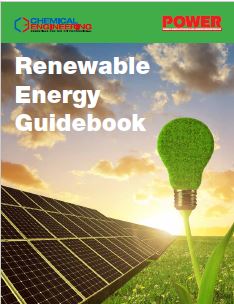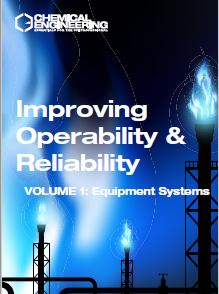Description
While the world continues to rely heavily on fossil fuels (petroleum, coal and gas) for power, efforts to develop more sustainable resources have caused remarkable growth in renewable energy.
This collection of recent articles from Chemical Engineering and POWER magazines presents a timely and informative overview of global efforts on many renewable energy fronts. It includes solar and wind power generation, advancements in geothermal and hydroelectric technology, and efforts to integrate such renewable sources into today’s electrical grid, such as through the use of large-scale energy storage devices. Also touched upon are bio-based renewable fuels, such as the use of biomass and waste for making solid, liquid, and gaseous fuels (including biogas), and techniques for using hydrogen as an energy carrier.
Delivered in a PDF format. 116 pages.
Articles Include:
Section One: News and Cover Stories
Concentrating Solar Thermal Power (CSP): The Future Looks Bright
New technology is helping to reduce costs and enabling CSP plants to generate electrical power 24 hours per day
Progress to Limit Climate Change
As world leaders agree on the need to reduce greenhouse gas (GHG) emissions, major milestones and new technologies point toward potential solutions
The Biogas Boom
New technologies are increasing production efficiencies, making this renewable energy source even more popular
Cutting-edge Composites: Materials for a New Era
The combination of advanced materials and processing techniques results in new composites that can aid industries in achieving increased levels of efficiency
Redox Flow Batteries Charge Forward
Developments in redox flow batteries are moving at a tremendous pace to meet the growing need for large scale energy-storage systems, which are used for stabilizing electric power distribution
Innovative Wind Turbine Blade Inspection and Maintenance Tools
Wind Power Projects Must Be Managed as Electrical Generation Plants
Wind turbine blades, gearboxes, and generators get most of the attention both within and beyond the power industry. The focus is often on increased capacity and blade lengths, as well as drive train premature failures. That’s natural, because those rotating blades are the most visible part of a wind project. However, successful operation of a wind installation also depends on attending to the many balance-of-plant components that are less visible.
Wind Turbine Generator Maintenance: What to Expect and Why
When most of today’s wind projects were developed, first costs were the focus; operations and maintenance (O&M) costs were largely unknown. Now, with hundreds of turbine models in operation—sometimes at a single site—O&M complexity is magnified, which makes understanding common failure modes and how to prepare for handling them essential.
Leveraging Generation Synergies with Hybrid Plants
Everyone loves efficiencies. Combining generation technologies can create a plant that’s more than the sum of its parts, but engineering challenges mean these projects are not for the faint of heart.
New Zealand Strives to Maximize the Value of Geothermal Wastewater
Using the heat from geothermal discharge water, or brine, is just one way to maximize the value of this “waste” stream. New Zealand, a geothermal energy leader, also is pursuing mineral extraction from brine to increase overall profitability of the sector.
The Outlook for Small Hydropower in China
As the global electric power industry continues to develop clean, high-quality energy capacity for sustainable development, the position of small hydropower has changed. In the past few decades, small hydropower development in China has experienced positive momentum, but there are still problems to be solved. To solve these problems, various relationships within the small hydropower industry must be rationalized to enable the sector to advance.
Reducing Weather-Related Risks in Renewable Generation
You can’t control the weather, but you can control how you handle the ways it affects your renewable plant. From financial hedging to accurate predictions, the tools in a plant owner’s arsenal are more capable than ever.
Agua Caliente Solar Project, Yuma County, Arizona
The 290-MW Agua Caliente Solar Project is the latest addition to the nation’s growing solar capacity and now holds the title as the largest photovoltaic plant in the world. The $1.8 billion project was completed in April 2014.
Ashta Hydropower Plant, Shkoder, Albania
Retrofitted to the outlet of a 30-year-old reservoir, the two-stage, 53-MW, 90-turbine Ashta Hydropower Plant on the Drin River in northwest Albania is a textbook example of how innovative run-of-river hydropower projects are harnessing latent generation worldwide.
Hometown BioEnergy, Le Sueur, Minnesota
Using agricultural and food-processing waste products, Hometown BioEnergy is helping the Minnesota. Municipal Power Agency meet state-mandated renewable energy standards while also providing a valuable fertilizer for area farmers and solid biomass as a fuel for other facilities.
London Array Offshore Wind Farm, Outer Thames Estuary, UK
The 175-turbine London Array wind farm was built on schedule, on a scale once thought unfeasible for the emergent offshore wind sector—and despite economic headwinds of the global recession and rough weather and sea conditions. Its success has been vital for the UK, which has anchored its energy future with offshore wind power.
Solana Generating Station, Maricopa County, Arizona
The 280-MW Solana Generating Station combines concentrating solar power (trough) technology with thermal energy storage, which allows the plant to operate after the sun goes down with up to a 38% annual average capacity factor. The $2 billion project began generating electricity in October 2013.
Alqueva II Pumped II Storage Hydropower Plant, Alqueva, Portugal
European Union carbon emission limitations and a lack of indigenous fossil fuel resources pushed Portugal in 2000 to embrace renewable energy. Today, Portugal supplies over 50% of its annual electricity demand from renewable resources, an increase of over 25% in the past five years alone. Leading Portugal’s renewable energy transformation is Alqueva II, a new pumped storage hydropower plant that supplies baseload electricity and backstops the large amount of variable wind generation in the south.
Macarthur Wind Farm, Victoria, Australia
Fully commissioned in January 2013, the 420-MW Macarthur Wind Farm is the largest wind farm in the Southern Hemisphere. But sourcing and erecting 140 wind turbines for this massive project was logistically challenging and required a rethink on several levels.
Mesquite Solar 1, Maricopa County, Arizona
Sempra U.S. Gas & Power’s jointly owned Mesquite Solar 1 project added 150 MW of photovoltaic-generated electricity to the grid in January 2013, making it one of the largest PV projects of its type in the country. Sempra U.S. Gas & Power’s long-term plan is to expand the facility to 700 MW.
Polaniec Green Unit, Polaniec, Poland
When Gérard Mestrallet, chairman and CEO of GDF SUEZ, set a target of doubling the company’s renewable energy capacity from 2007 to 2013, it seemed very ambitious. Projects like the Polaniec Green Unit have helped the company reach its goal with room to spare.
Shams 1, Madinat Zayed, United Arab Emirates
The Arabian Peninsula might seem like the ideal location for a concentrating solar power plant, but developers of the 100-MW Shams 1 CSP project in the UAE—the world’s largest at its inauguration in March— found that things were nowhere near that simple.
Alamosa Solar Project, San Luis Valley, Colorado
As the largest solar plant of its type in the world, the 30-MW Alamosa Solar Project is currently enjoying its place in the sun. The innovative project consists of 504 concentrating photovoltaic (CPV) solar trackers, each featuring a CPV solar cell panel assembly mounted on a support column. The modular design of the assembly allows the project to easily accommodate future improvements in cell technology.
Coca-Cola/Mas Energy Trigeneration Facility, Atlanta, Georgia
By taking a waste product and converting it into a fuel source, the 6.5-MW Coca-Cola/Mas Energy Facility became the first U.S. operational trigeneration project fueled by landfill gas. Since March, the new system has provided electricity, steam, and chilled water to the adjacent Coca-Cola Syrup Plant, satisfying most of the plant’s energy requirements and reducing its long-term energy costs.
Gujarat Solar Park, State of Gujarat, India
Set up by the Gujarat government, the Gujarat Solar Park is actually a group of solar parks that provide dedicated common infrastructure for photovoltaic-powered projects owned and operated by numerous individual companies. When construction at all the parks is completed by the end of 2013, the Gujarat Solar Park is projected to reach a combined capacity of almost 1,000 MW, which will make it the world’s largest solar energy generation installation.
Stillwater Solar-Geothermal Hybrid Plant, Churchill County, Nevada
The Stillwater hybrid facility is the world’s first renewable energy project that pairs geothermal power’s baseload generation capacity with solar power’s peak capacity. Inaugurated in May, the 26-MW solar plant is integrated with the adjacent 33-MW geothermal plant, which began operations in 2009, and provides energy to run the geothermal plant’s auxiliary loads.
Three Gorges Dam, Yangtze River, Hubei Province, China
After nine years of construction, installation, and testing, the Three Gorges Dam is now complete. On May 23, 2012, the last main generator finished its final test, increasing the facility’s capacity to 22.5 GW and making it the world’s largest capacity hydroelectric power plant.
Walney Offshore Windfarms, Irish Sea, UK
Officially commissioned in February 2012, the two Walney Offshore Windfarms—Walney 1 and Walney 2—together have 102 wind turbines with a total capacity of 367.2 MW. With their combined capacity, the windfarms qualify as one of the world’s largest offshore wind energy facilities and provide clean electricity to approximately 320,000 UK households.
Section Two: Technology Briefs
‘Anode-less’ lithium battery prototype doubles energy density
Scaleup for modular H2 production via PEM electrolysis
Dry adhesive technology mimics gecko’s feet
A hybrid solar cell that utilizes waste heat to boost efficiency
A system to extract energy from waste gases
A very efficient heat exchanger for very hot applications
Alkylate process featuring a solid-acid catalyst can use multiple feedstocks
Air-capture of CO2 using waste process heat
An efficient cycle for utilizing waste heat
Bacteria make lactic acid from palm waste
An organic waste-to-biogas system to be scaled up in first installation
A promising process to recover Li from seawater
A process for making longer carbon nanotubes
This process converts organic food waste to liquid fertilizer
This PEM fuel cell has H2 storage built-in
This electrochemical cell sequesters CO2 and generates electricity
This coating makes glass into a solar panel
Making a mercury-removing polymer from industrial waste
This ‘ultrabattery’ makes its commercial debut
Large-scale production of carbon nanotubes
Modular hydrogen-production technology uses modified SMR process
Solar-electric hybrid furnace could enable improved magnesium processing
Recover waste heat with ORC technology
Reduce energy costs by combining wastewater treatment and desalination
Progress for high-efficiency ammonia-cogeneration plant
Pilot plant slated for a fast-pyrolysis process that converts biomass into fuels
A step forward for the bio-production of L-arginine
Paint a thermoelectric device onto any shaped surface to recover waste heat
An inexpensive adsorbant for removing silver from wastewater
Monetizing coke-oven gas, while capturing CO2
Collaboration lowers cost for bio-based FDME process
Making fuels from almost any organic material
Modified MOFs could cut carbon-capture costs in half
Tin-based catalyst for photodecomposition
Making bio-oils via solvent liquefaction
Section Two: Technology Briefs
An enzymatic route to lignin-based functional chemicals
Improving the efficiency of solar desalination
Fuel-cell-based carbon capture system can augment power generation
A 3-D printed polymer with enzymes turns methane to methanol
Continuous crude-oil production from algae
Selectively recover CO with this soft nano-porous material
Commercial debut for a low-cost stationary energy-storage system
In-situ chemical remediation of soil and groundwater
The commercial debut for a gas-to-gasoline process
Combine wastewater treatment with biofuel production
The launch of a new bioethylene-production process
Biomass torrefaction plant undergoing expansion
Bioelectrochemical system treats wastewater and generates biogas
A new catalyst may reduce costs of catalytic converters
Xylenes production method takes advantage of low-cost methanol feedstock
Electrode design increases efficiency of suspended-solids removal
Using air and hydrostatic pressure to store energy underwater
Removing harmful metals from wastewater with crab shells




